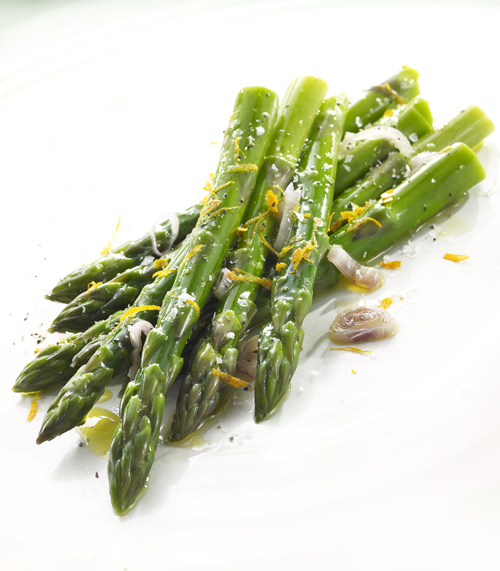Photo by David Bishop
I have loved asparagus since I was a small child. My mother served it often with butter and salt & pepper. In my adult years, upon discovering shallots and the wonders of fresh lemon juice and zest , I have been making my recipe for Asparagus with Shallots and Lemon for many years. The first time I took a plate of this dish to a neighborhood buffet dinner party, the plate was emptied immediately. People were asking me for the recipe because they loved it so much. I went back home and made another platter of it to bring back to the party. Mine was the only vegetable dish, aside from a green salad, the others being popular heavy meat, cheese and starch foods. I was delighted with my recipe’s reception.
Asparagus, with it’s delicate flavor and tender succulent flesh, has been prized as a delicacy since ancient times, especially in Ancient Egypt, Rome and Greece, and was and still is known for its cleansing and healing properties. Asparagus has often appeared in high brow recipes such as Asparagus alla Hollandaise, though in modern times has become ubiquitous in food markets and is easily procured at modest means. It is a pantheon of health foods with high fiber and nutrients, and has a low calorie count of 36 calories per cup. It can be useful both as cure and preventative for disease.
According to the Michigan Asparagus Advisory Board, “Asparagus is one of the most nutritionally well-balanced vegetables in existence. It leads nearly all produce items in the wide array of nutrients it supplies in significant amounts for a healthy diet.” (http://www.asparagus.org/maab/nutrition.html). Wikipedia sites that “Studies have shown that people who have died from Alzheimer’s Disease have extremely low to no levels of folate”, folate being one of the important nutrients in asparagus, among many others. (http://en.wikipedia.org/wiki/Asparagus)
Other experts agree that asparagus is high in antioxidants and amino acids, has little fat and high protein, is low in sodium and is a diuretic. Furthermore, it is also a great source for: calcium, magnesium, zinc, folic acid, thiamin, riboflavin, rutin, niacine, glutathione, (http://www.doctoroz.com/videos/superhero-antioxidants-pt-1, http://www.amazing-glutathione.com/what-foods-have-glutathione. html, http://www.effectsofglutathione.com/), iron, phosphorus, potassium, copper, manganese, selenium, and chromium, “a trace mineral that enhances the ability of insulin to transport glucose from the bloodstream into cells.” (http://en.wikipedia.org/wiki/Asparagus) This last tidbit is especially useful for diabetics.
Asparagus is especially known to cleanse the liver and kidneys It is also found to help cure gout by dissolving uric acid in the the extremities, and help in bowel evacuation. Water from cooking asparagus is considered to alleviate facial blemishes.
There is much scientific research on the matter of how asparagus makes your pee odorous. After having read them all I still believe that it is it’s property of cleansing the liver and kidneys that causes the phenomenon. Asparagus simply makes your pee smell because it releases the accumulated toxins from your body.
I share with you here my recipe for Asparagus with Shallots and Lemon.
Recipe serves 4 as a side dish: 54 calories per serving
- 1 bunch of asparagus, about 8 ounces or 2 cups, 72 calories
- 2 shallots, thinly sliced, 1.75 – 2 ounces, 14-16 calories
- I lemon, zested and juiced, zest is 3 calories per Tablespoon, juice is 8- 10 calories for 1.75 ounces. I used a Meyers lemon for the rich color and sweeter taste.
- 1 tablespoons olive oil, 120 calories
- Flake sea salt and ground black pepper to taste, as a finish
- 2 quarts of boiling sea salted water (about 1/8 cup all purpose sea salt)
- 2 quarts of ice water in a large bowl
- Trim the pale woody ends off the stalks of the washed asparagus. (You can use the ends to make vegetable stock later with trimmings of other vegetables)
- Boil the asparagus tips until they are just about tender to the teeth. (I bite the largest cut end of one to check)
- Remove the asparagus from the boiling water and place into the ice bath to preserve the bright green color. Drain and dry them thoroughly just before the finished cooking process.
- In a skillet amply sized to accommodate all of the asparagus single file, saute the shallots in the olive oil on medium low heat until slightly golden brown.
- Add into the skillet the drained and dried asparagus and stir to coat them with the oil and shallots.
- Add into the skillet the lemon juice and half of the lemon zest and continue to cook for a few minutes, tossing all the while. The juices and oil will emulsify to form a glaze.
- Remove everything to a plate with tongs and season with flaked sea salt and freshly ground pepper to taste.
- Garnish with the rest of the lemon zest.
Serve and enjoy as a side dish with your favorite entree and whole grain, or add to a salad.
Also visit my professional website at www.marilinda.com and my food column on the Huffingon post at http://www.huffingtonpost.com/marilinda-hodgdon/
